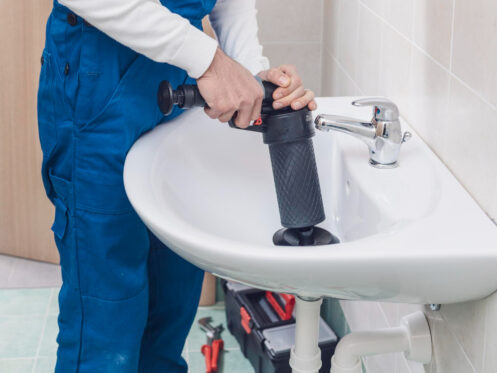A slow drain is typically caused by a partial clog somewhere in your plumbing system. The most frequent culprits include hair buildup around pop-up stoppers in bathroom sinks, accumulated soap scum narrowing the drain passage, or objects that have fallen into the drain. In bathrooms, the combination of hair, soap, and toothpaste creates a sticky mess that gradually restricts water flow.
Homeowners often use chemical drain cleaners without success, and this happens because some clogs are physical blockages that chemicals can’t dissolve. In other cases, inadequate venting in your plumbing system might create back pressure that prevents water from draining properly. Understanding the specific cause of your slow drain is the first step toward fixing it permanently rather than dealing with recurring issues.
Common Causes of Slow Drains
Slow drains typically stem from several key issues that develop over time in our home plumbing systems. Understanding these causes can help identify and resolve drainage problems before they worsen and require expensive professional intervention.
Obstructions from Debris and Buildup
Hair is one of the most common culprits in bathroom drains, as it tangle together and traps soap scum, creating stubborn clogs that restrict water flow. Soap scum and mineral deposits build up slowly over months or years, and these substances create a sticky layer inside drain pipes that narrows the passage for water and catches additional debris.
Food particles play a similar role in kitchen sinks, gradually accumulating along pipe walls. Grease and cooking oils are particularly problematic in kitchen drains. When hot grease cools, it solidifies and adheres to pipe walls. This sticky coating captures food particles and eventually creates significant blockages. Foreign objects like small toys, jewelry, or hygiene products can also become lodged in the drain pipes. These unexpected obstructions often create immediate and severe drainage issues.
Poor Pipe Installation and Maintenance Issues
Pipes should have a slight downward angle (¼ inch per foot) to facilitate proper drainage. Improper pipe slope prevents gravity from effectively moving water through the system. Aging pipes develop internal roughness, corrosion, and buildup over time, creating more surface area for debris to cling to and narrowing the pipe diameter. Inadequate venting also creates air pressure problems within the plumbing system. Without proper ventilation, negative pressure can slow drainage significantly or cause gurgling sounds.
Effects of Garbage Disposal Usage on Drainage
Always run cold water when using the disposal and for 15-20 seconds afterward to flush debris through the pipes. Certain foods should never enter a garbage disposal. Fibrous vegetables, coffee grounds, eggshells, and starchy foods can create a paste-like substance that coats pipes.
Disposal units without sufficient power may not grind waste thoroughly, and partially ground food particles can accumulate downstream in the plumbing system. Running ice cubes through the disposal monthly helps clean the grinding components to maintain proper function and reduce drainage issues. Disposal systems also require periodic maintenance to prevent drain problems. Check for leaks around the unit and listen for unusual noises that might indicate mechanical issues affecting performance.
Assessing Your Home Drainage System
When dealing with slow drains, thoroughly check your entire drainage system. A systematic inspection helps pinpoint exactly where and why water isn’t flowing properly.
Identifying Slow-Draining Sinks and Showers
The first sign of drainage problems is water taking longer than usual to go down the pipes, so watch your kitchen sink while doing dishes – does water pool instead of draining immediately? In showers, check if water rises above your ankles during normal use.
Time your drains for an objective assessment. A properly functioning sink should empty within seconds after you pull the plug. If it takes more than a minute, you likely have a partial blockage. Look for patterns in slow drainage. Is only one fixture affected, or multiple drains throughout your home? A single slow drain often indicates a localized clog in that fixture’s pipe. Multiple slow drains might signal a larger issue in your main sewer line.
Checking for Standing Water in Dishwasher and Sinks
Check your dishwasher after a cycle completes – a small amount of water at the bottom is normal, but significant pooling isn’t. In sinks, look for water that remains in the basin long after use. Also, examine the cabinet underneath for moisture, water stains, or warped wood. These signs indicate a leaking drain pipe contributing to slow drainage. For bathtubs and showers, remove the drain cover and use a flashlight to look for visible hair or soap scum buildups that could be restricting water flow.
Determining If Clean Outs Are Accessible and Clear
Cleanouts are critical access points to your plumbing system, and these capped pipes allow for inspection and clearing of your drainage lines. Locate your main cleanout, typically found near the foundation of your home or in the basement, and ensure it’s accessible and not buried, covered by furniture, or hidden behind fixtures.
Check if the clean-out cap can be removed easily (though don’t remove it unless you’re prepared to deal with potential drainage). A stuck or corroded cap might need professional attention. Look around the clean-out area for signs of previous sewage backups like water stains or residue. These indicate your system has experienced serious blockages before and might need thorough professional cleaning.
Troubleshooting and Solving Slow-Drain Issues
Slow drains can be fixed with simple DIY methodsor may require professional help, depending on the severity of the clog. The right approach depends on where the blockage is located and what’s causing it.
Using a Plunger and Drain Cleaner Effectively
A plunger is often your first line of defense against slow drains. For sinks, use a cup-style plunger and create a tight seal around the drain. Push down and pull up rapidly several times to dislodge the clog. If plunging doesn’t work, try a drain cleaner. There are three main types:
- Chemical cleaners: Work well on hair and soap scum but can damage pipes if used too often.
- Enzymatic cleaners: Safer for pipes and break down organic matter.
- Homemade solutions: Baking soda followed by vinegar can help with minor clogs.
Pour the cleaner directly into the drain and wait the recommended time before flushing with hot water. Always read product instructions carefully and wear gloves to protect your skin. For stubborn clogs, try a drain snake to physically remove blockages.
When to Opt for Professional Drainage Solutions
Call a professional when:
- Multiple drains in your home are slow at the same time
- DIY methods haven’t worked after 2-3 attempts
- The clog keeps returning despite your efforts
- You notice foul smells coming from the drains
Professional plumbershave specialized equipment like motorized augers and hydro-jetters that can clear even the most stubborn blockages. They can also use camera inspections to identify the exact location and cause of the problem.
Sometimes slow drains indicate larger issues like inadequate venting or problems with your main sewer line. These require professional expertise to diagnose and fix properly. The cost of professional drain cleaningtypically ranges from $100-300, which is worth it to prevent more expensive damage to your plumbing system.
Contact usto arrange a professional inspection of your plumbing system.












